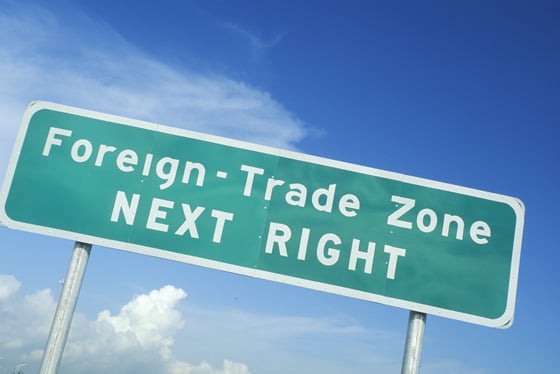The International Trade Blog Import Procedures
Foreign Trade Zones: Advantages for Importers and Exporters
On: January 13, 2020 | By:  Arnesh Roy |
5 min. read
Arnesh Roy |
5 min. read
 If you import or export, you may be familiar with the terms foreign trade zone and free trade zone, both of which are frequently abbreviated as FTZ. These terms are often used interchangeably to refer to a class of government-run duty-free zones, but they actually mean slightly different things.
If you import or export, you may be familiar with the terms foreign trade zone and free trade zone, both of which are frequently abbreviated as FTZ. These terms are often used interchangeably to refer to a class of government-run duty-free zones, but they actually mean slightly different things.
Free trade zone is a more general, universal term. Customs authorities representing governments across the globe have established free trade zones. Free trade zones are areas in which commodities can be manufactured, modified or stored under specific customs regulations and generally not subject to customs duties.
According to U.S. Customs and Border Protection (CBP), foreign trade zones are the United States’ version of free trade zones. FTZs are designated areas within the United States that are legally located outside of the customs territory of the United States, meaning that goods that reside within an established FTZ haven’t yet cleared customs.
Companies utilize FTZs to save money and to make their products more competitive not only in the U.S. but around the world.
Avoiding or Delaying Duty Payments
Foreign trade zones allow companies to legally avoid paying duties and merchandise processing fees (MPF), delay these payments, and pay a lower duty rate. They may also choose to pay import duties on either the raw materials or finished goods, depending on which duty rate is lower (this is called inverted duty savings.) Overall, FTZs allow companies to operate their supply chain more effectively.
John Shoffner, Administrator and Business Development Manager of the Greater Metropolitan Area Foreign Trade Zone (FTZ #119) serving the Twin Cities area in Minnesota, describes how Red Wing Shoes utilizes an FTZ to avoid or delay paying duties.
When Red Wing Shoes imports a container of shoes from China, the container can sit in the FTZ for four to five months. If they then ultimately sell those shoes to a customer in another country, they can do so without ever having to pay U.S. import duties. If they sell those shoes to a U.S.-based retailer, they pay the duty at the time when the product is actually sold and leaves the FTZ. In essence, the FTZ allows Red Wing Shoes to pay duties when they invoice their customers, which helps them better manage their cash flow.
Shoffner also talks of a company that manufactures engines. If they import a crankshaft from their supplier, they must pay an eight percent duty rate. However, if they bring the crankshaft into the FTZ and build the finished engine there, the finished product can be imported duty free.
Reducing Merchandise Processing Fees
U.S. Customs and Border Protection (CBP) imposes a Merchandise Processing Fee (MPF) on most imports that can range from $26 to $508. For informal entries, the fee ranges from $2 to $9 per shipment. This fee is distinct from the duties importers may also have to pay.
Shoffner explains that companies shouldn’t underestimate the power of FTZ-enabled savings on MPFs. He describes an example of one company that did 10,000 imports a year; in other words, they had to pay the MPF 10,000 times. By utilizing an FTZ, this company was able to consolidate their imports into 50 separate entries, which saved them a significant amount of money. Many companies save more on the MPFs than they save on duties.
Zone-to-Zone Transfers
Companies can also transfer goods located within a U.S.-based FTZ to another FTZ and maintain the benefits. For example, if a company has 10 distribution centers located across the United States they can send products from one FTZ to any other FTZ in the U.S. without paying any duties or MPFs until they are ready.
This ability to transfer between distribution centers is especially helpful for large manufacturers such as car companies that are importing components and transferring parts between manufacturing facilities and distribution centers. That way manufacturers can ensure they have the parts they need nearby.
In fact, a lot of large manufacturers require their tier one suppliers to be in FTZs. Shoffner gives an example of an IoT (internet of things) supplier that he works with that was recently asked to set up their operation in an FTZ. Most of their finished goods include components that were originally imported, so utilizing FTZs was a natural next step in expanding their business.
Joining a Foreign Trade Zone
A Foreign Trade Zone must be located near a CBP port of entry. You’ll find a complete list of FTZs in the United States at the Trade & Industry Development website. A company does not need to be physically located within the borders of an FTZ to take advantage of its benefits.
If your company is interested in utilizing an FTZ, you should start by locating the nearest FTZ and then contacting it’s administrative office for help conducting an initial assessment of the costs and benefits. These initial assessments often include a review of your imports focusing on how much you spend on duties and fees. This should be measured against the cost of implementing a system to manage your operations within the FTZ.
If the initial assessment looks good, Shoffner says companies often hire a consultant to do a more detailed analysis.
When Shoffner receives an inquiry from a company interested in utilizing his FTZ, one of the first things he does is introduce them to another company already using the FTZ, so they can get a firsthand account of the experience. While he doesn’t sit in on these calls, he often gets feedback afterwards something along the lines of, “I wish we had done this 10 years ago.”
Shoffner explains that most companies who want to join an FTZ will apply for subzone status. Subzone is a general term referring to “a site or group of sites established for a specific use.” In practice, there are two types of subzone: an alternative site framework (ASF), which is available if the intended operations are to take place within 60 miles or 90 minutes of the nearest FTZ; and a traditional site framework (TSF), which is for areas that fall outside of that range.
To apply for ASF status, a company must submit a Minor Boundary Modification (MBM) application. To apply for TSF status, they must submit a TSF Application. Both of these are done online on the U.S. Foreign Trade Zones Board website.
These applications are reviewed by the national FTZ Board. An ASF application takes 30 days to be approved, whereas the TSF application takes three months.
Benefits of Foreign Trade Zones to the United States
The official, published purpose of FTZs is to create and retain U.S. jobs. All of the FTZ operators have to report the volume and other statistics of what went through their FTZ each year. Those reports get rolled up into the national report, which then gets sent to the U.S. Congress.
The most recent national report was for 2018. According to the report, there were 195 FTZs. More than 440,000 people were employed at the approximately 3,300 firms that utilized an FTZ. Shipments into the network of FTZs were valued at more than $793 billion. Sixty-three percent of those shipments were domestic goods, which indicates that the majority of the FTZ operations were combining those domestic goods with foreign goods.
U.S. exports from facilities operating within a foreign trade zone amounted to more than $112 billion.
Shoffner says that most of the company-specific numbers are proprietary information, but recalls a case of a company that recently started utilizing his FTZ. This company was able to redirect key product lines to Minnesota, leading to new growth for the company and economic stability for the state.
Like what you read? Join thousands of exporters and importers who subscribe to Passages: The International Trade Blog. You'll get the latest news and tips for exporters and importers delivered right to your inbox.

About the Author: Arnesh Roy
Arnesh Roy was a Senior Inside Sales Representative at Shipping Solutions.



